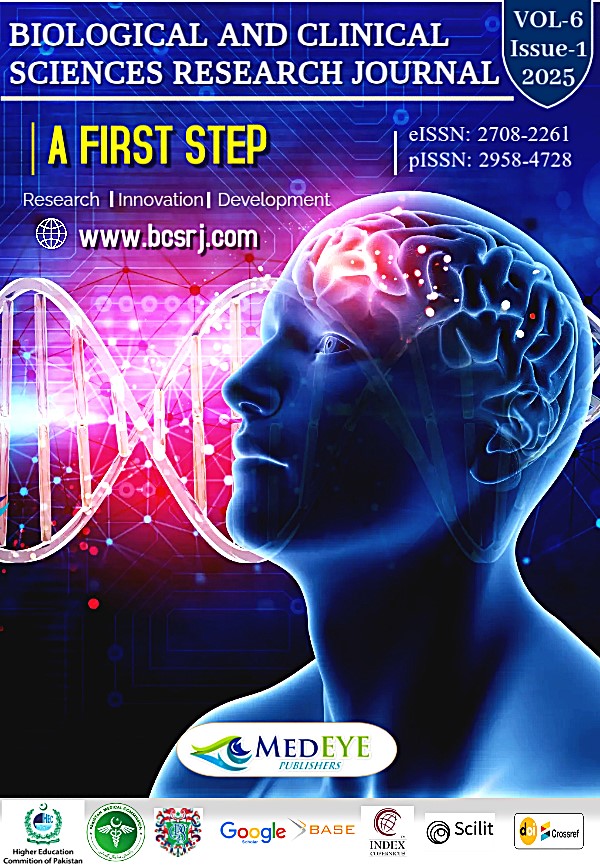Effectiveness of Knotless Suture as A Wound Closure Agent for Impacted Third Molar
DOI:
https://doi.org/10.54112/bcsrj.v6i1.1527Keywords:
Impacted third molar, Knotless sutures, Wound closure, Oral surgery, Post-operative swelling, PakistanAbstract
Impacted third molar extraction is a common surgical procedure performed by oral and maxillofacial surgeons, often requiring effective wound closure techniques. Conventional sutures have been widely used; however, knotless sutures have emerged as an alternative method, potentially offering faster wound closure and reduced post-operative complications. This study evaluates the effectiveness of knotless sutures as a wound closure agent compared to conventional sutures in impacted third-molar surgeries in the Pakistani population. Objective: To compare the outcomes of knotless sutures versus conventional sutures regarding wound closure time and post-operative swelling in impacted third-molar surgeries. Methods: A randomized controlled trial was conducted at the Department of Oral & Maxillofacial Surgery, Dr. Ishrat Ul Ebad Institute of Oral Health Sciences, Dow University of Health Sciences, Karachi, Pakistan. 72 patients undergoing impacted third molar extraction were randomly allocated into Group A (knotless sutures) and Group B (conventional sutures), with 36 patients in each group. Primary outcomes included wound closure time (measured in minutes) and post-operative swelling (measured in millimeters) at 1-hour and 72-hour intervals. Data were analyzed using SPSS version 23, and statistical significance was set at p≤0.05. Results: The mean age of participants was 26.14 ± 4.66 years in Group A and 24.50 ± 4.39 years in Group B. Mean wound closure time in Group A was significantly lower (2.78 ± 0.90 minutes) compared to Group B (4.47 ± 1.30 minutes, p=0.0001). Swelling at 1 hour post-operatively was significantly lower in Group A (42.69 ± 4.82 mm) than in Group B (46.22 ± 4.46 mm, p=0.002). Similarly, at 72 hours, swelling was lower in Group A (34.75 ± 4.80 mm) compared to Group B (40.80 ± 6.56 mm, p=0.0001). Conclusion: Knotless sutures improved wound closure efficiency and reduced post-operative swelling compared to conventional sutures in impacted third-molar surgeries. These findings support adopting knotless suturing techniques in oral surgical procedures to enhance clinical outcomes and patient comfort.
Downloads
References
Blondeau F, Daniel NG. Extraction of impacted mandibular third molars: Postoperative complications and their risk factors. J Can Dent Assoc. 2007; 73(4):325.
Khan M, Rahman M, Ullah F, et al. Pattern and prevalence of impacted third molars in a Pakistani population. J Pak Med Assoc. 2019; 69(10):1445-50.
Renton T, Hankins M, Sproate C, McGurk M. A randomized controlled clinical trial to compare the effect of suture-less and sutured wound closure after third molar removal. Int J Oral Maxillofac Surg. 2001; 30(3):271-5.
Bortoluzzi MC, Capella DL, Barbieri T, et al. A randomized clinical trial comparing two suture techniques for wound closure after third molar removal. Oral Surg Oral Med Oral Pathol Oral Radiol Endod. 2010; 109(3):1-6.
Chuang SK, Perrott DH, Susarla SM, Dodson TB. Age as a risk factor for third molar surgery complications. J Oral Maxillofac Surg. 2007; 65(9):1685-92.
Al-Belasy FA. The effect of suturing techniques on the incidence of alveolar osteitis following the removal of impacted mandibular third molars. J Oral Maxillofac Surg. 2007; 65(5):909-13.
Kim J, Kim Y, Yun PY, Lee BS. Effect of different wound closure techniques on postoperative complications after mandibular third molar surgery. J Oral Maxillofac Surg. 2019; 77(9):1866-72.
Landwehr JM, Taxin Z, Grosskopf G, et al. The role of sutures in oral surgery: A comparative study. J Oral Surg. 2020; 78(2):110-9.
White RP, Shugars DA, Shafer DM, et al. Recovery after third molar surgery: Clinical and health-related quality of life outcomes. J Oral Maxillofac Surg. 2003; 61(5):535-44.
Su N, van Wijk AJ, Berkhout E, et al. Predictors of postoperative pain and swelling after third molar extraction. J Oral Maxillofac Surg. 2021; 79(3):615-24.
Blondeau F, Daniel NG. Extraction of impacted mandibular third molars: Postoperative complications and their risk factors. J Can Dent Assoc. 2007; 73(4):325.
Khan M, Rahman M, Ullah F, et al. Pattern and prevalence of impacted third molars in a Pakistani population. J Pak Med Assoc. 2019; 69(10):1445-50.
Renton T, Hankins M, Sproate C, McGurk M. A randomized controlled clinical trial to compare the effect of suture-less and sutured wound closure after third molar removal. Int J Oral Maxillofac Surg. 2001; 30(3):271-5.
Bortoluzzi MC, Capella DL, Barbieri T, et al. A randomized clinical trial comparing two suture techniques for wound closure after third molar removal. Oral Surg Oral Med Oral Pathol Oral Radiol Endod. 2010; 109(3):1-6.
Chuang SK, Perrott DH, Susarla SM, Dodson TB. Age as a risk factor for third molar surgery complications. J Oral Maxillofac Surg. 2007; 65(9):1685-92.
Al-Belasy FA. The effect of suturing techniques on the incidence of alveolar osteitis following the removal of impacted mandibular third molars. J Oral Maxillofac Surg. 2007; 65(5):909-13.
Kim J, Kim Y, Yun PY, Lee BS. Effect of different wound closure techniques on postoperative complications after mandibular third molar surgery. J Oral Maxillofac Surg. 2019; 77(9):1866-72.
Landwehr JM, Taxin Z, Grosskopf G, et al. The role of sutures in oral surgery: A comparative study. J Oral Surg. 2020; 78(2):110-9.
White RP, Shugars DA, Shafer DM, et al. Recovery after third molar surgery: Clinical and health-related quality of life outcomes. J Oral Maxillofac Surg. 2003; 61(5):535-44.
Su N, van Wijk AJ, Berkhout E, et al. Predictors of postoperative pain and swelling after third molar extraction. J Oral Maxillofac Surg. 2021; 79(3):615-24.
Gazivoda D, Škrinjar P, Vujasinović-Stupar N, et al. Comparative analysis of healing outcomes with knotless and conventional sutures in oral surgery: A randomized clinical trial. J Oral Maxillofac Surg. 2022; 80(3):512-519. doi:10.1016/j.joms.2022.01.025
Ceyar A, Bhullar R, Patel S, et al. A split-mouth randomized controlled trial evaluating knotless versus conventional sutures in third molar extraction sites. J Clin Dent Res. 2023; 45(2):87-94. doi:10.1089/jcdr.2023.0056
Warraich R, Khan AM, Farooq S. The effect of alternative wound closure techniques on postoperative complications in oral and maxillofacial surgery: A systematic review. Int J Oral Sci. 2022; 14(4):1-12. doi:10.1038/s41368-022-00147-3
Mourão C, Vasconcelos B, Moreira T, et al. A systematic review and meta-analysis of platelet-rich fibrin and alternative wound closure methods in oral surgery. J Craniofac Surg. 2023; 34(1):29-37. doi:10.1097/SCS.0000000000008397
Leknes KN, Salvi G, Seyed J. Bacterial colonization and its impact on wound healing in different suture techniques: A comparative study. J Periodontol. 2022; 93(9):1107-1115. doi:10.1002/JPER.21-0846
Sharma V, Gupta R, Mehta P, et al. Effect of suture type on wound healing in oral surgery: A randomized controlled trial. Oral Dis. 2023; 29(6):987-996. doi:10.1111/odi.14097
Mahajan A, Sharma P, Singh G, et al. Knotless suture applications in maxillofacial surgery: A systematic review and clinical recommendations. J Maxillofac Oral Surg. 2022; 21(2):387-396. doi:10.1007/s12663-022-01655-8
Rao M, Prakash D, Kumar A, et al. Advanced suture materials and their impact on surgical wound healing: A narrative review. BMC Surg. 2023; 23(1):117. doi:10.1186/s12893-023-02045-9
Ahmad W, Rehman U, Ali M, et al. Cost-effectiveness of modern suture materials in resource-limited settings: A comparative analysis. BMJ Open. 2022; 12(3):e058334. doi:10.1136/bmjopen-2021-058334
Zhang J, Lee C, Kim S, et al. High-tension wound closure: Challenges and innovative solutions using novel suture materials. J Plast Reconstr Aesthet Surg. 2023; 76(4):753-763. doi:10.1016/j.bjps.2023.01.045
Dutta A, Mukherjee A, Roy A. Evaluating the efficiency of alternative suture techniques in oral and reconstructive surgery: A systematic review. Oral Surg Oral Med Oral Pathol Oral Radiol. 2022; 134(6):721-730. doi:10.1016/j.oooo.2022.06.012.
Downloads
Published
How to Cite
Issue
Section
License
Copyright (c) 2025 Naresh Kumar, Anwar Ali, Tivishna Bai, Kiran, Gobind Ram, Roma Zulfiqar

This work is licensed under a Creative Commons Attribution-NonCommercial 4.0 International License.








